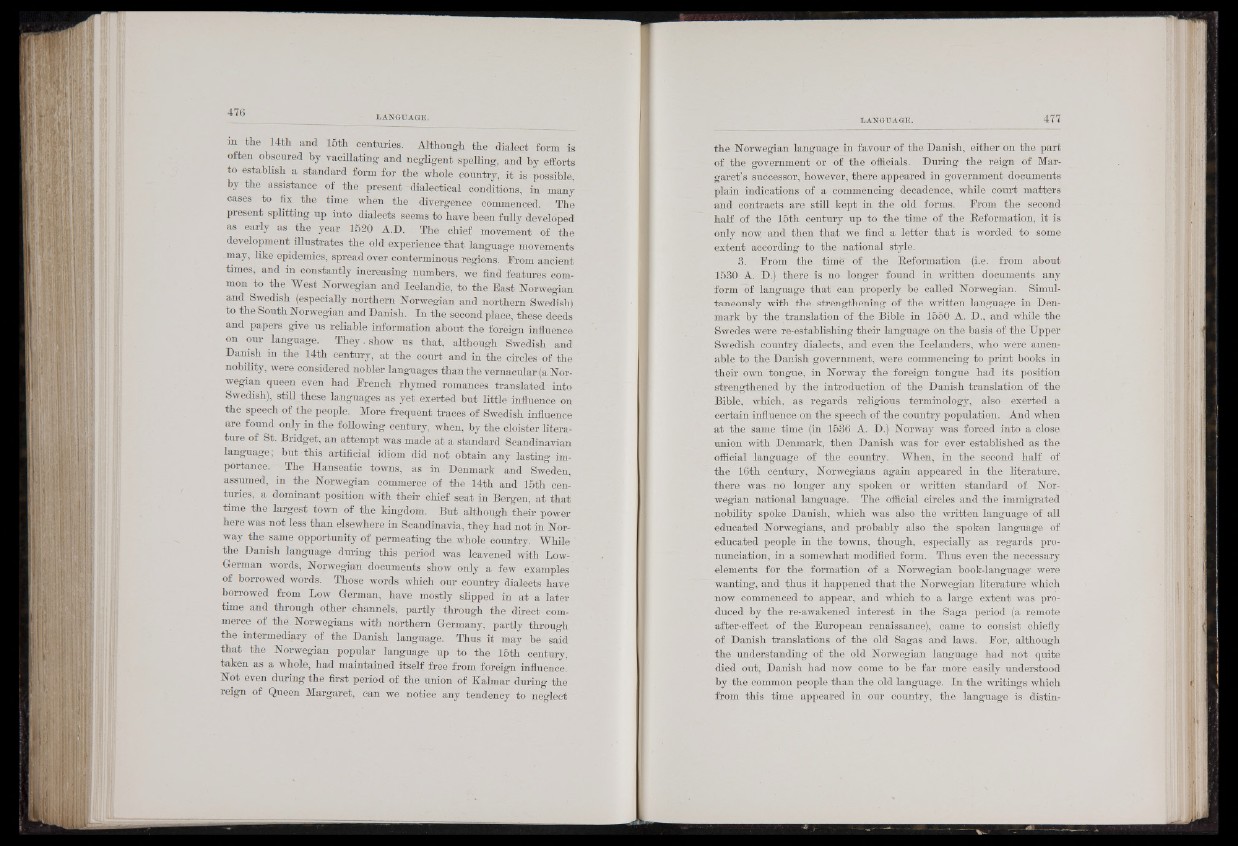
in the 14th and 15th centuries. Although the dialect form is
often obscured by vacillating and negligent spelling, and by efforts
to establish a standard form for the whole country, it is possible,
by the assistance of the present dialectical conditions, in many
cases to fix the time when the divergence commenced. The
present splitting up into dialects seems to have been fully developed
as early as the year 1520 A.D. The chief movement of the
development illustrates the old experience that language movements
may, like epidemics, spread over conterminous regions. From ancient
times, and in constantly increasing numbers, we find features common
to the West Norwegian and Icelandic, to the East Norwegian
and Swedish (especially northern Norwegian and northern Swedish)
to the South Norwegian and Danish. In the second place, these deeds
and papers give us reliable information about the foreign influence
on our language. They. show us that, although Swedish and
Danish in the 14th century, at the court and in the circles of the
nobility, were considered nobler languages than the vernacular (a Norwegian
queen even had French rhymed romances translated into
Swedish), still these languages as yet exerted but little influence on
the speech of the people. More frequent traces of Swedish influence
are found only in the following century, when, by the cloister literature
of St. Bridget, an attempt was made at a standard Scandinavian
language; but this artificial idiom did not obtain any lasting importance.
The Hanseatic towns, as in Denmark and Sweden,
assumed, in the Norwegian commerce of the 14th and 15th centuries,
a dominant position with their chief seat in Bergen, at that
time the largest town of the kingdom. But although their power
here was not less than elsewhere in Scandinavia, they had not in Norway
the- same opportunity of permeating the_whole country. While '
the Danish language during this period was leavened with Low-
German words, Norwegian documents show only a few examples
of borrowed words. Those words which our country dialects have
borrowed from Low German, have mostly slipped in at a later
time and through other channels, partly through the direct commerce
of the Norwegians with northern Germany, partly through
the intermediary of the Danish language. Thus it may be said
that the Norwegian popular language up to the 15th century,
taken as a whole, had maintained itself free from foreign influence.
Not even during the first period of the union of Kalmar during the
reign of Queen Margaret, can we notice any tendency to neglect
the Norwegian language in favour of the Danish, either on the part
of the government or of the officials. During the reign of Margaret’s
successor, however, there appeared in government documents
plain indications of a commencing decadence, while court matters
and contracts are still kept in the old forms. From the second
half of the 15th century up to the time of the Reformation, it is
only now. and then that we find a letter that is worded to some
extent according to the national style.
3. From the time of the Reformation (i.e. from about
1530 A. D.) there is no longer found in written documents any
form of language that can properly be called Norwegian. Simultaneously
with the- strengthening of the written language in Denmark
by the translation of the Bible in 1550 A. D., and while the
Swedes were re-establishing their language on the basis of the Upper
Swedish country dialects, and even the Icelanders, who were amenable
to the Danish government, were commencing to print books in
their own tongue, in Norway the foreign tongue had its position
strengthened by the introduction of the Danish translation of the
Bible, which, as regards religious terminology, also exerted a
certain influence on the speech of the country population. And when
a t the same time (in 1536 A. D.) Norway was forced into a close
union with Denmark, then Danish was for ever established as the
official language of the country. When, in the second half of
the 16th century, Norwegians again appeared in the literature,
there was no longer any spoken or written standard of. Norwegian
national language. The official circles and the immigrated
nobility spoke Danish, which was also the written language of all
educated Norwegians, and probably also the spoken language of
educated people in the towns, though, especially as regards pronunciation,
in a somewhat modified form. Thus even the necessary
elements for the formation of a Norwegian book-language were
wanting, and thus it happened that the Norwegian literature which
now commenced to appear, and which to a large extent was produced
by the re-awakened interest in the Saga period (a remote
after-effect of the European renaissance), came to consist chiefly
of Danish translations of the old Sagas and laws. For, although
the understanding of the old Norwegian language had not quite
died out, Danish had now come to be far more easily understood
by the common people than the old language. In the writings which
from this time appeared in our country, the language is distin